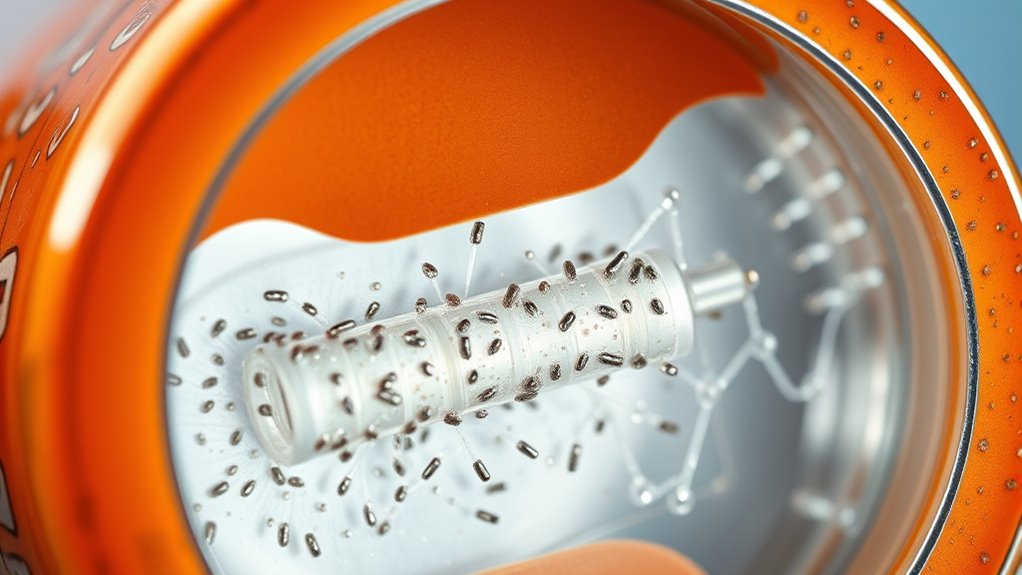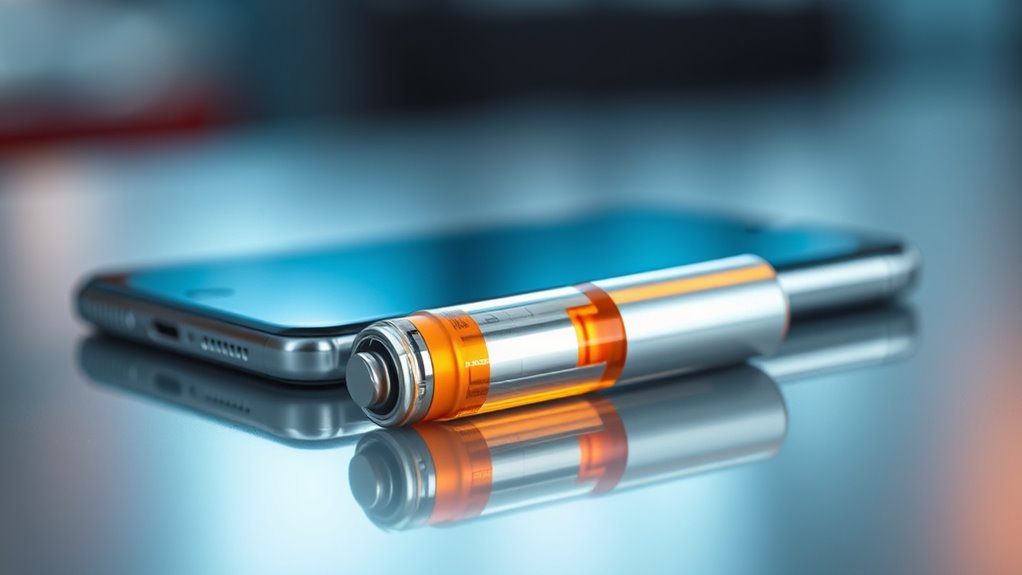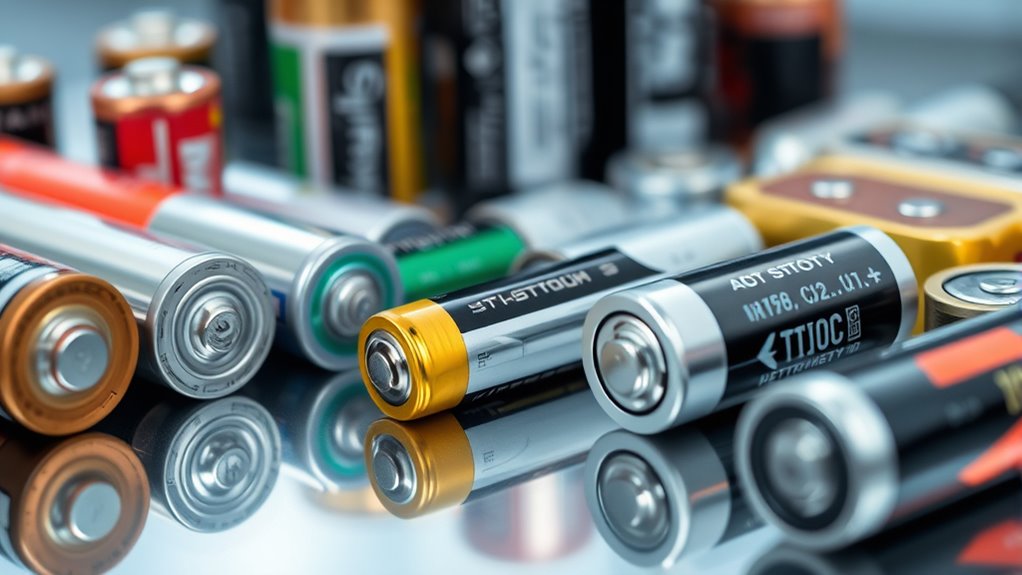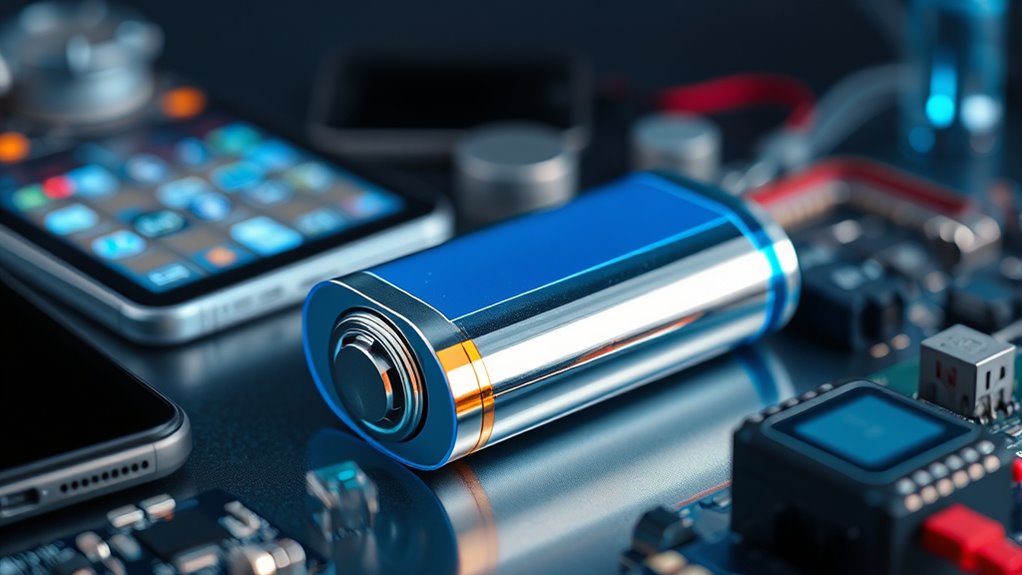Batteries power your gadgets by converting stored chemical energy into electrical energy through controlled reactions between the anode, cathode, and electrolyte. Electrons flow from the anode to the cathode in an external circuit, powering your devices, while ions move within the battery to balance charges. Different types of batteries use specific chemistries to optimize performance. To discover how these tiny energy sources work inside your gadgets, keep exploring the fascinating chemistry behind them.
Key Takeaways
- Batteries convert chemical energy into electrical energy through oxidation and reduction reactions at electrodes.
- Electrons flow from the anode to the cathode via an external circuit, powering connected devices.
- Ions move within the electrolyte to balance charge during the battery’s operation.
- The movement of lithium ions in rechargeable batteries generates electrical current for gadgets.
- Internal components like separators and current collectors facilitate safe and efficient energy transfer.
The Inner Workings of Battery Chemistry

Understanding how batteries work begins with their chemical reactions. Inside the battery, chemical energy transforms into electrical energy through reactions between two electrodes: the anode (negative) and cathode (positive). These reactions are responsible for generating the electrical current that powers your devices. Electrons are generated at the anode and flow through an external circuit to the cathode, powering your devices. Simultaneously, ions move within the electrolyte to balance charge, maintaining neutrality. These reactions involve oxidation at the anode and reduction at the cathode, with the electrolyte facilitating ion movement but not electrons. This process creates a voltage difference that drives electron flow. In rechargeable batteries, these reactions are reversible, allowing electrons and ions to flow in both directions during charging and discharging. The chemical reactions and ion flow are fundamental to how batteries deliver consistent power for your gadgets.
Key Components That Make Batteries Function

The operation of a battery depends on several key components working together to convert chemical energy into electrical energy efficiently and safely. The electrodes, anode and cathode, are where oxidation and reduction occur, releasing and accepting electrons, respectively. They also store ions like lithium, essential for charge transfer. These components facilitate the flow of ions and electrons, making the electrochemical reactions possible. The electrolyte acts as the medium for ion flow between electrodes, enabling electrochemical reactions while blocking electrons to prevent short circuits. The separator is a thin polymer film that keeps the electrodes apart, preventing contact but allowing ions to pass through, maintaining safety and efficiency. Additionally, advances in battery materials are driving improvements in energy density and lifespan. Current collectors, made of conductive metals such as aluminum and copper, gather and transport electrons to the external circuit. Terminals connect the battery to your device, facilitating the flow of power needed to run your gadgets.
How Batteries Power Your Everyday Devices

Lithium-ion batteries are the powerhouse behind most of your everyday devices, providing reliable and portable energy. Their high energy density lets your smartphones, laptops, and wireless earbuds stay compact and lightweight while delivering ample power.
The rechargeability means you can cycle through hundreds of charges without significant loss, keeping your devices ready when you need them. Fast charging capabilities reduce downtime, so you spend less time plugged in.
Widespread adoption of lithium-ion tech in electric vehicles, energy storage, and IoT devices shows how dependable they are. These batteries power your devices through the movement of lithium ions between the anode and cathode, generating electrical flow. This process is supported by battery chemistry that ensures consistent performance and safety.
Their efficiency and safety features make them essential for daily use, ensuring your gadgets stay charged and ready to go whenever you are. [This is why ongoing research focuses on improving battery safety and longevity.
Different Types of Batteries and Their Uses

Different types of batteries serve various needs, from powering small gadgets to supporting large vehicles. Primary batteries, like alkaline and zinc-air, are non-rechargeable and ideal for disposable devices such as remote controls or hearing aids.
Secondary batteries, including lithium-ion and nickel-metal hydride, are rechargeable and commonly used in smartphones, laptops, and hybrid cars. Lithium-ion batteries offer high energy density, making them perfect for portable electronics, while NiMH batteries are popular in cordless tools.
Lead-acid batteries power cars and backup systems, and lithium polymer batteries suit drones due to their lightweight, high power density. Specialty batteries like button cells and coin cells fit small devices like watches and remote controls.
Each type’s design and chemistry tailor them to specific applications, balancing performance, longevity, and environmental impact. Contrast ratio plays a crucial role in how clearly images appear, especially in dark scenes or detailed visuals.
Innovations Shaping the Future of Battery Technology

Advancements in battery technology are transforming how we power our devices and vehicles, driven by innovations in materials, chemistry, and structural design. You might see lithium batteries combining graphite with silicon anodes, boosting capacity and lifespan. Researchers are using tungsten, carbon nanotubes, and nanostructured electrodes to improve charge rates and energy storage.
Zinc-manganese oxide batteries promise higher density at lower costs, while sand-derived silicon offers longer-lasting performance. Chemistries like lithium metal and seawater-based solutions aim to double energy density and speed up charging. Track development in mixing techniques can further optimize performance and impact.
Structural innovations, such as batteries integrated into structures and ultra-fast charging technologies, reduce space and downtime. These breakthroughs support a cleaner, more efficient energy future by making batteries safer, cheaper, and more sustainable.
The Impact of Batteries on Portable and Industrial Power

Innovations in battery technology are transforming how we power portable devices and industrial equipment. Lithium-ion batteries, with their high power density and light weight, are ideal for industrial uses like manufacturing, data centers, and renewable energy systems. They guarantee continuous power, preventing costly disruptions and equipment failures while protecting sensitive machinery from power surges. Additionally, advanced fraud detection techniques help ensure the security and integrity of transactions involving battery-related equipment purchases. Portable batteries cut emissions considerably compared to fuel-powered generators, offering silent, zero-emission power solutions that improve safety. They also help businesses reduce energy costs by load balancing and avoiding peak rates. Environmentally, batteries support renewable integration and lower reliance on fossil fuels, reducing pollution and noise. Their adoption enhances operational efficiency, decreases downtime, and promotes sustainability, making them crucial to modern industrial and portable power needs.
Frequently Asked Questions
How Long Do Batteries Typically Last Before Needing Replacement or Recharging?
You probably wonder how long your batteries last before needing a recharge or replacement. Generally, batteries in devices last from a few hours to several years, depending on usage and type.
For example, rechargeable batteries in gadgets like smartphones can often be recharged hundreds of times, while disposable batteries may last weeks or months.
Proper care, like avoiding extreme temperatures and not overcharging, helps extend their lifespan.
Can Batteries Be Recycled or Reused to Reduce Environmental Impact?
Think of batteries as treasures waiting to be reborn. You can recycle or reuse them, turning waste into valuable resources.
Recycling methods like hydrometallurgical recover metals, while direct recycling preserves cathodes for reuse.
Reusing batteries extends their life and reduces environmental harm.
With growing innovations, you play an essential role in protecting the planet, ensuring that these power sources don’t just end up as waste but become part of a sustainable cycle.
What Safety Precautions Should Be Taken When Handling or Disposing of Batteries?
When handling or disposing of batteries, you should wear approved PPE like safety glasses and gloves to prevent acid burns or injuries.
Make sure the area is well-ventilated to avoid hydrogen gas buildup, and keep sparks or flames away.
Disconnect power before maintenance, store batteries upright at room temperature, and secure terminals during transport.
Follow proper recycling protocols, tape terminals, and never incinerate batteries to guarantee safety and environmental protection.
How Do Temperature Changes Affect Battery Performance and Lifespan?
Temperature changes considerably impact your battery’s performance and lifespan. Cold temperatures slow down chemical reactions, reducing capacity and power output.
Extreme heat speeds up aging and degrades the battery faster. You might notice shorter usage times in cold weather or quicker capacity loss in heat.
To keep your battery healthy, avoid extreme temperatures, use proper thermal management, and store your gadgets within recommended temperature ranges.
Are There Any New Battery Technologies That Could Replace Current Types?
You’re curious if new battery technologies might replace current types. Innovations like solid-state batteries, zinc-air, sodium-ion, and dual carbon systems promise faster charging, longer lifespan, and improved safety.
These advancements could soon power your devices more efficiently and sustainably. As they develop and scale, you’ll likely see them become the new standard, transforming how your gadgets operate and making energy storage safer, cheaper, and more reliable.
Conclusion
So, next time your gadgets run out of juice, remember—you’re relying on complex chemistry that’s been powering your life quietly and efficiently. Ironically, it’s this invisible dance of electrons and chemicals that keeps your world spinning, yet most of us barely give it a second thought. As batteries evolve, perhaps someday we’ll marvel at how simple solutions once kept us connected—until then, enjoy the silent, sparkling marvels powering your daily routine.









